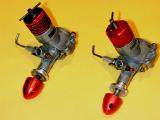DC Merlin
![]()
| Name | DC Merlin | Designer | Davis-Charlton |
| Type | Compression Ignition | Capacity | 0.75cc |
| Production run | Lots | Country of Origin | England |
| Photo by | Ron C | Year of manufacture | 1950's onwards |
Notes:
The DC Merlin and Super Merlin enjoyed great popularity as a powerplant for free flight sport and free flight scale models in the UK and Australia. This would not be due to their power, which can best be described as modest, but more likely the compact, light design allowing the Merlin to be enclosed where a Mills could not. The "Super" designation meant the engine was fitted with an anodized spinner nut and a plastic fuel tank; the internals being essentially the same, or so Aeromodeller articles would have me believe.
 My lack of total confidence in this assertions arrises from the two engines in my collection. One is definitely a Super Merlin having come to me with the aforementioned spinner nut and a twisted, shrunken, distorted mess that was once a fuel tank that attached via the two backplate retention bolts and nuts. The other arrived as a generous gift with no nut at all, no tank, and no conrod. The missing rod was no problem, being of what Bert Striegler calls the British "dog-bone" design, noteworthy as being symetrical--both big and little end are reamed 1/8". The surprise however lay at the front of the engine. I copied the contour and 4BA thread of the Super Merlin when making the missing spinner nut and got a very unpleasent surprise when I found it would not fit the shaft which turned out to have a 3BA thread! This was rectified using the 3BA tap from my BA set which I believe was a virgin up until this operation (who ever heard of anything being threaded 3BA?). But I have incontrovertable evidence of 3 and 4 BA threaded shafts--possibly the 3BA represents a later design intended to make the shaft more crash-resiliant.
My lack of total confidence in this assertions arrises from the two engines in my collection. One is definitely a Super Merlin having come to me with the aforementioned spinner nut and a twisted, shrunken, distorted mess that was once a fuel tank that attached via the two backplate retention bolts and nuts. The other arrived as a generous gift with no nut at all, no tank, and no conrod. The missing rod was no problem, being of what Bert Striegler calls the British "dog-bone" design, noteworthy as being symetrical--both big and little end are reamed 1/8". The surprise however lay at the front of the engine. I copied the contour and 4BA thread of the Super Merlin when making the missing spinner nut and got a very unpleasent surprise when I found it would not fit the shaft which turned out to have a 3BA thread! This was rectified using the 3BA tap from my BA set which I believe was a virgin up until this operation (who ever heard of anything being threaded 3BA?). But I have incontrovertable evidence of 3 and 4 BA threaded shafts--possibly the 3BA represents a later design intended to make the shaft more crash-resiliant.
A note for Merlin owners, there is a red fiber gasket that fits under the exhaust port band of the liner. This gasket not only seals the crankcase for primary compression, it also sets the "deck" height of the cylinder and thus, the transfer/exhaust ports. If it's missing, or too thin, transfer does not occur and you've no chance of ever starting the engine. With the correct gasket in place, the Merlin is a docile, easy starting engine of modest power, able to be "throttled back" by slackening off the compression to spin a 8x4 wood prop comfortably--doubtless, a reason it gained popularity with the FF scale community.
![]()
